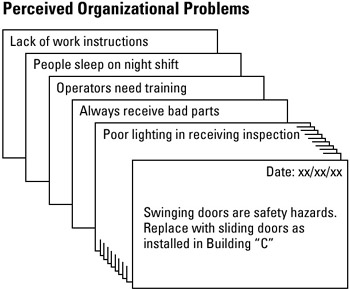Tool 47: Crawford Slip Method
| AKA | Crawford Slip Writing |
| Classification | Idea Generating (IG) |
Tool description
Pioneered by C. C. Crawford, the Crawford Slip method is a structured approach used to collect a large number of ideas from a group. A facilitator first displays a problem statement or issue, then participants generate ideas and write them on a provided slip of paper or 3 5 index card. Since this is an anonymous process, more candid and creative ideas result.
Typical application
-
To generate anonymously ideas on how to deal with a sensitive issue or topic.
-
To identify real and perceived problem areas in the organization.
-
To collect ideas for process, product, or service imporovement.
-
To produce potential problem-solving solutions.
Problem-solving phase
| → | Select and define problem or opportunity |
| → | Identify and analyze causes or potential change |
| → | Develop and plan possible solutions or change |
| Implement and evaluate solution or change | |
| Measure and report solution or change results | |
| Recognize and reward team efforts |
Typically used by
| Research/statistics | |
| 1 | Creativity/innovation |
| Engineering | |
| 4 | Project management |
| Manufacturing | |
| 2 | Marketing/sales |
| Administration/documentation | |
| Servicing/support | |
| Customer/quality metrics | |
| 3 | Change management |
before
-
Buzz Group
-
Weighted Voting
-
Sticking Dots
-
Checklist
-
Interview Technique
after
-
Value analysis
-
Criteria Filtering
-
Multivoting
-
Consensus Decision Making
-
Nominal Group Technique (NGT)
Notes and key points
-
The Crawford Slip method of brainstorming:
Advantages
-
Any size group (small to large).
-
Any seating arrangement.
-
Broader participation (includes less expressive participants).
-
Large quantity of ideas.
-
Good for sensitive topics since participants' input is anonymous, without team interaction.
-
Easier process of sorting ideas.
Disadvantages
-
Overall slow process.
-
Cannot build on other ideas (piggybacking).
-
Written ideas may not be legible or clear.
-
Written ideas may be stated as a word when they require a lengthy paragraph.
-
Step-by-step procedure
-
STEP 1 A facilitator explains the procedure to the team (or large group) and hands out slips of paper or 3 5 index cards to each participant.
-
STEP 2 A flip chart with a written problem statement or an issue to be brainstormed is displayed to the team.
-
STEP 3 Participants respond by writing their ideas on the provided papers, one idea per paper or card, and then pass them to the facilitator. See example Perceived Organizational Problems.
-
STEP 4 This process continues for approximately 25 minutes, and the rest of the additional ideas are handed to the facilitator.
-
STEP 5 If this process was completed with a relatively small team of 6-12 participants, ideas can now be sorted by frequency and category. Ideas from a large group would require sorting and analysis at a later date.
Example of tool application
Perceived Organizational Problems

EAN: 2147483647
Pages: 326